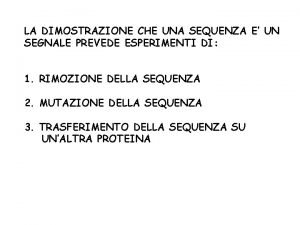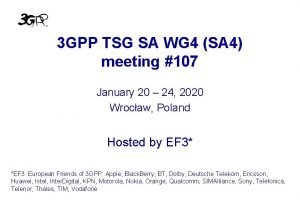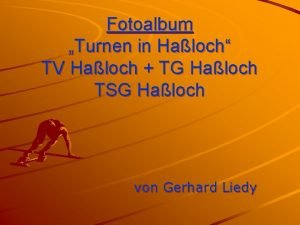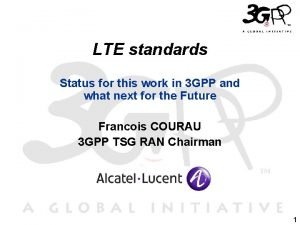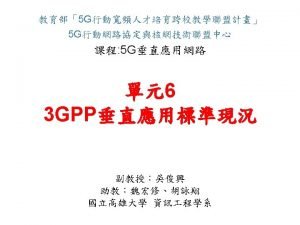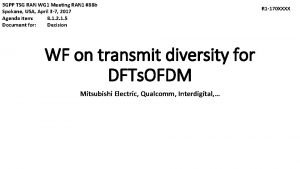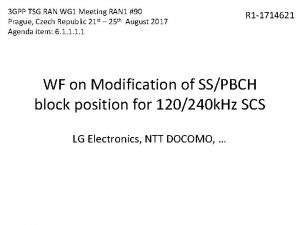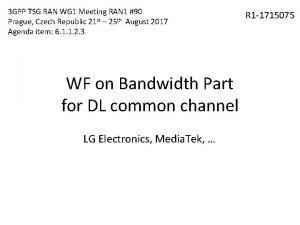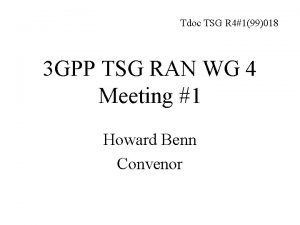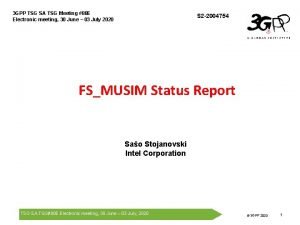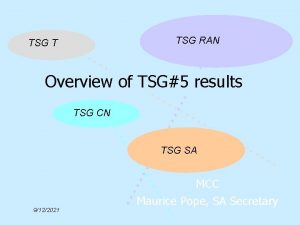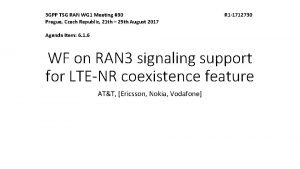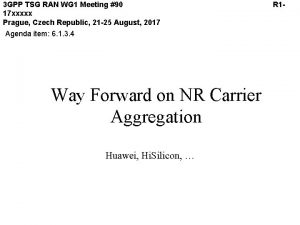3 GPP TSG RAN WG 4 Meeting 94

![Background • Deployment Scenarios from some operators were presented [1]. See figure below. • Background • Deployment Scenarios from some operators were presented [1]. See figure below. •](https://slidetodoc.com/presentation_image_h/30281e3ad4598293efe7e7d02f621dce/image-2.jpg)






![General Requirements - OBW • Option 1 [2]: OBW requirement is met when the General Requirements - OBW • Option 1 [2]: OBW requirement is met when the](https://slidetodoc.com/presentation_image_h/30281e3ad4598293efe7e7d02f621dce/image-9.jpg)
- Slides: 9

3 GPP TSG RAN WG 4 Meeting #94 e Electronic Meeting, 24 Feb 6 Mar 2020 WF on Intra-band Noncontiguous ULCA TX Architectures and Issues Qualcomm, Skyworks, KDDI, [Huawei], […] R 4 2002812
![Background Deployment Scenarios from some operators were presented 1 See figure below Background • Deployment Scenarios from some operators were presented [1]. See figure below. •](https://slidetodoc.com/presentation_image_h/30281e3ad4598293efe7e7d02f621dce/image-2.jpg)
Background • Deployment Scenarios from some operators were presented [1]. See figure below. • 2 UL/3 DL • Wide range of [BWCC 1 + Wgap + BWCC 2] • UL MIMO preference • 2 PA/2 LO was proposed as architecture to be used for Non-contiguous ULCA [2] • General requirements were proposed. See Appendix • Baseline architecture depends on maximum aggregated BW • Due to UL-MIMO preference and cases where BWCA is relatively small, 2 PA/2 LO was deemed too restrictive and 1 PA should not be precluded. [1] • • 1 PA/1 LO was mentioned as alternative with LO exception [1] [2] 1 PA/1 LO could have relaxed in-gap ACLR requirement [3] 2 PA could be specified by UE capability declaration if Wgap gets too wide 1 PA/2 LO consideration [4] • Current UE capability signalling [5] [6] • “dual. PA-Architecture” as part of the CA NR paramters IE – UE indicates 2 PA for intra-band ULCA • “max. Number. MIMO[CB or non. CB]-Layers-PUSCH” as part of the Feature set Uplink parameters IE – UE indicates max number of MIMO layers per CC with/without codebook

WF • Confirm and agree on general requirements in Appendix. • Investigate MPR impact, UL MIMO capability, and feasibility as a function of CABW, CCBW, and Wgap for the following architectures (maximum number of ULCCs = 2). • 2 PA/2 LO • 1 PA/1 LO • 1 PA/2 LO • Study the feasibility of re-using ENDC MPR for NC-ULCA with 2 PA/2 LO • Investigate need for any additional UL MIMO capability for release 16. • Investigate in-gap requirement for 1 PA/1 LO case. • ACLR relaxation as a function of CABW • Regulatory compliance of LO exception • Investigate Impact on Coexistence due to IMD and need for AMPR or UL RB allocation restriction. • • • Radio Altimeter (4. 2 -4. 4 G) Same Band (other operator in n 77) Adjacent Bands (n 79 for NC-ULCA in n 77) [NS_04, NS_27] [WIFI (5. 2 -5. 8 G)]

Reference 1. R 4 -2002691 RAN 4_94 e email discussion, Section 3. 3. 1 2. R 4 -2000104 On intra-band UL non-contiguous CA requirement for FR 2, Qualcomm 3. R 4 -1913807 NR ULCA Image Issue for in gap ACLR, Skyworks 4. TR 36. 833 -4 (V 12. 0. 0) 5. TS 38. 306 v 15. 8 (2019 -12) 6. TS 38. 311 v 15. 8 (2019 -12) 7. R 4 -2001772 CR for intra-band UL CA RF requirements, Huawei

Appendix • General Requirements for Non-contiguous ULCA

General Requirements – Composite SEM • Where two masks overlap, the most relaxed limit is used. • Composite spectrum emission mask applies to frequencies up to Δf. OOB starting from the edges of the sub-blocks • If for some frequency an individual sub-block spectrum emission mask overlaps with the bandwidth of another sub-block, the emission mask does not apply for that frequency.

General Spurious Emissions • The spurious emission limits apply for the frequency ranges that are more than ∆FOOB (MHz) from the edge of the aggregated channel bandwidth for frequencies in the gap and out of the gap. For frequencies ΔFOOB greater than FOOB, the spurious emission requirements in Table 6. 5. 3 -2 (TS 38. 101 -1) are applicable • No spurious requirement applies in the gap if Wgap < ∆FOOB 1 + ∆FOOB 2, otherwise only composite SEM applies as shown in Figure 2. 1 -1.

General Requirements - ACLR Adjacent Channel Leakage Power Ratio is the ratio of the sum of the filtered mean powers centered on each of the assigned carrier frequency to the filtered mean power centered on an adjacent carrier frequency at nominal channel spacing equal to the aggregated bandwidth of the carrier. Measurement BW is the aggregated carrier bandwidth minus twice the maximum of the guard bands of the carriers. No ACLR requirement if Wgap < max(CC 1 BW, CC 2 BW) to prevent excessive in-band emission with other sub-block. No ACLR requirement Image case without declaring 2 PA (FFS)
![General Requirements OBW Option 1 2 OBW requirement is met when the General Requirements - OBW • Option 1 [2]: OBW requirement is met when the](https://slidetodoc.com/presentation_image_h/30281e3ad4598293efe7e7d02f621dce/image-9.jpg)
General Requirements - OBW • Option 1 [2]: OBW requirement is met when the ratio of the transmitted power in all CCs of the ULCA configuration to the total integrated power of the transmitted spectrum is greater than 99%. • Option 2 [7]: For intra-band non-contiguous carrier aggregation sub-block occupied bandwidth is defined as the bandwidth containing 99 % of the total integrated mean power of the transmitted spectrum on the sub-block. In case the sub-block consist of one component carrier the occupied bandwidth of the sub-block shall be less than the channel bandwidth specified in Table 6. 5. 1 -1. No requirement applies to a sub-block if: • a) the frequency span between the lowest edge of the aggregated channel bandwidth of the sub-block and the highest edge of the aggregated channel bandwidth of a lower subblock is smaller than FOOB_L+FOOB • b) the frequency span between the highest edge of the aggregated channel bandwidth of the sub-block and the lowest edge of the aggregated channel bandwidth of a higher subblock is smaller than FOOB+FOOB_H • Where FOOB, FOOB_L and FOOB_H are defined as aggregated channel bandwidth of the subblock+5 MHz, in case of CA, or channel bandwidth+5 MHz in case of single carrier respectively.
